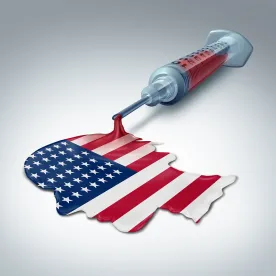The Biologics Price Competition and Innovation Act (BPCIA) has been criticized for creating a complicated framework for resolving patent disputes, often referred to as the biosimilar “patent dance.” Unlike the Hatch-Waxman framework for resolving patent disputes surrounding generic drugs, the BPCIA does not require the “brand name” biologic company to list its patents in an equivalent to the Orange Book, but instead requires parties to go through a multi-step exchange of “patent lists” to determine the patents at issue. The Biologic Patent Transparency Act introduced by Sen. Collins (R-Maine) aims to shrink the patent dance floor by creating a new, mandatory list of biological product patents and prohibiting enforcement of non-listed patents.
The Biologic Patent Transparency Act
Currently, the FDA publishes the “Purple Book” for biologic drugs, but unlike the Orange Book, the Purple Book does not include patent information. Rather, the Purple Book lists approved biological products, their date of approval, and any biosimilar or interchangeable biological products licensed by FDA. That could change if S. 659, also known as the “Biologic Patent Transparency Act,” becomes law.
S. 659 would require the FDA to publish “a single, easily searchable, list” of approved biological products and patents identified by the biological product license holder, to be updated every 30 days. The biological product license holder would be required to disclose “any patent” it owns or has exclusively licensed for which it believes “a claim of patent infringement could reasonably be asserted … if a person not licensed by the holder engaged in the making, using, offering to sell, selling, or importing into the United States of the biological product.” The biological product license holder also would be required to notify FDA within 30 days if any listed patent or claim thereof is “determined to be invalid or unenforceable.”
S. 659 would modify the “patent dance” provisions of the BPCIA to restrict the patents that can be listed on a “patent list” to those timely disclosed to the FDA. Further, S. 659 would modify the patent infringement statute (35 USC §271) by adding subparagraph (e)(7):
(7) The owner of a patent that should have been included in the list described in section 351(o)(1) of the Public Health Service Act (42 U.S.C. 262(o)(1)), including any updates required under subparagraph (C) of that section, but was not timely included in such list, may not bring an action under this section for infringement of the patent.
Missteps In The Patent Dance
While the biosimilar patent dance might benefit from simplification, companies that develop original biologic products are likely to believe the Biologic Patent Transparency Act goes a few steps too far. The Hatch-Waxman framework does not require originators to advise the FDA if specific claims of a patent are “determined to be invalid or unenforceable,” although a patent may be delisted. The Hatch-Waxman framework imposes consequences for “late listing” a patent, but it does not bar infringement claims for late-listed patents altogether. Indeed, since the Hatch-Waxman framework does not permit listing of method of manufacture patents, it does not bar infringement claims for non-listed patents, but only omits them from pre-marketing ANDA disputes. Why should originators of new biologic products have to do more fancy footwork than originators of new drug products?
On the other side of the dance floor, biosimilar developers may find that the Biologic Patent Transparency Act does not make the patent dance that much easier. While the listing requirements would identify the patents that could be raised in a patent dance, the harsh consequences for non-listing would encourage originators to list every patent that might reasonably be asserted against as-yet unknown competitors making as-yet unknown biosimilar products by as-yet unknown processes. The relevance of each patent to a given biosimilar product made by a given process still would have to be assessed on a case-by-case basis, and determined via the exchanges of “patent lists” that make the patent dance so complicated to begin with.




 />i
/>i

